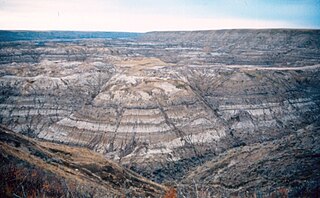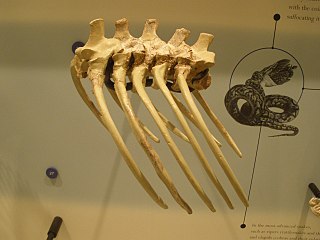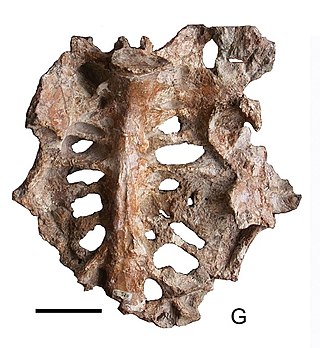
Rapetosaurus is a genus of titanosaurian sauropod dinosaur that lived in Madagascar from 70 to 66 million years ago, at the end of the Cretaceous Period. Only one species, Rapetosaurus krausei, has been identified.

Pachyrhinosaurus is an extinct genus of centrosaurine ceratopsid dinosaur from the Late Cretaceous period of North America. The first examples were discovered by Charles M. Sternberg in Alberta, Canada, in 1946, and named in 1950. Over a dozen partial skulls and a large assortment of other fossils from various species have been found in Alberta and Alaska. A great number were not available for study until the 1980s, resulting in a relatively recent increase of interest in Pachyrhinosaurus.

Olorotitan was a monotypic genus of lambeosaurine duck-billed dinosaur, containing a single species, Olorotitan arharensis. It was among the last surviving non-avian dinosaurs to go extinct during the Cretaceous–Paleogene extinction event, having lived from the middle to late Maastrichtian-age of the Late Cretaceous era. The remains were found in the Udurchukan Formation beds of Kundur, Arkharinsky District, Amur Oblast, Eastern Russia, in the vicinity of the Amur River.

Pyroraptor is an extinct genus of paravian dinosaur, probably a dromaeosaurid or unenlagiid, from the Late Cretaceous Ibero-Armorican island, of what is now southern France. It lived during the late Campanian and early Maastrichtian stages, approximately 72 million years ago. It is known from a single partial specimen that was found in Provence in 1992, after a forest fire. The animal was named Pyroraptor olympius by Allain and Taquet in 2000.

Rhabdodon is a genus of ornithopod dinosaur that lived in Europe approximately 70-66 million years ago in the Late Cretaceous. It is similar in build to a very robust "hypsilophodont", though all modern phylogenetic analyses find this to be an unnatural grouping, and Rhabdodon to be a basal member of Iguanodontia. It was large amongst its relatives, measuring 4 m (13 ft) long and weighing 250 kg (550 lb), with some specimens possibly reaching up to 6 m (20 ft) long.

Tenontosaurus is a genus of iguanodontian ornithopod dinosaur. It had an unusually long, broad tail, which like its back was stiffened with a network of bony tendons.

Ampelosaurus is a titanosaurian sauropod dinosaur from the Late Cretaceous Period of what is now France. Its type species is A. atacis, named by Le Loeuff in 1995. Its remains were found in a level dating from 71.5 million years ago representing the early Maastrichtian.

Majungasaurus is a genus of abelisaurid theropod dinosaur that lived in Madagascar from 70 to 66 million years ago, at the end of the Cretaceous Period, making it one of the last-known non-avian dinosaurs that went extinct during the Cretaceous–Paleogene extinction event. The genus contains a single species, Majungasaurus crenatissimus. This dinosaur is also called Majungatholus, a name which is considered a junior synonym of Majungasaurus.

Lirainosaurus is a genus of titanosaur sauropod which lived in what is now Spain. The type species, Lirainosaurus astibiae, was described by Sanz, Powell, Le Loeuff, Martinez, and Pereda-Suberbiola in 1999. It was a relatively small sauropod, measuring 4 metres (13 ft) long, possibly up to 6 metres (20 ft) long for the largest individuals, and weighed about 2–4 metric tons.

The Horseshoe Canyon Formation is a stratigraphic unit of the Western Canada Sedimentary Basin in southwestern Alberta. It takes its name from Horseshoe Canyon, an area of badlands near Drumheller.

Madtsoiidae is an extinct family of mostly Gondwanan snakes with a fossil record extending from early Cenomanian to late Pleistocene strata located in South America, Africa, India, Australia and Southern Europe. Madtsoiidae include very primitive snakes, which like extant boas and pythons would likely dispatch their prey by constriction. Genera include some of the longest snakes known such as Vasuki, measuring at least 11–15 metres (36–49 ft) long, and the Australian Wonambi and Yurlunggur. As a grouping of basal forms the composition and even the validity of Madtsoiidae is in a state of flux as new pertinent finds are described, with more recent evidence suggesting that it is paraphyletic as previously defined.

The Lameta Formation, also known as the Infratrappean Beds, is a sedimentary geological formation found in Madhya Pradesh, Gujarat, Maharashtra, Telangana, and Andhra Pradesh, India, associated with the Deccan Traps. It is of the Maastrichtian age, and is notable for its dinosaur fossils.

Gargantuavis is an extinct genus of large, primitive bird containing the single species Gargantuavis philoinos. It is the only member of the monotypic family Gargantuaviidae. Its fossils were discovered in several formations dating to 73.5 and 71.5 million years ago in what is now northern Spain, Southern France, and Romania. Gargantuavis is the largest known bird of the Mesozoic, a size ranging between the cassowary and the ostrich, and a mass of 141 kg (311 lb) like modern ostriches, exemplifying the extinction of non-avian dinosaurs wasn't a necessary condition for the emergence of giant terrestrial birds. It was once thought to be closely related to modern birds, but the 2019 discovery of a pelvis identified as cf. Elopteryx nopcsai from what was Hateg Island shows several primitive features.

Madtsoia is an extinct genus of madtsoiid snakes. It is known from the Eocene of Argentina, the Paleocene of Brazil, the Late Cretaceous (Maastrichtian) of India, and the Late Cretaceous (Maastrichtian) of Madagascar. The type species was the largest with an estimated length of 9–10 m (30–33 ft), and the other three species were smaller. A 5.1 m (17 ft) long M. madagascariensis would have weighed 50 kg (110 lb), but an isolated specimen suggests that this species reached 8 m (26 ft) in maximum length.

Musturzabalsuchus is an extinct monospecific genus of allodaposuchid eusuchian crocodyliform. The type and only species is Musturzabalsuchus buffetauti.
The Sierra Perenchiza Formation is a late Campanian to late Maastrichtian geologic formation in Spain. Dinosaur, pterosaur, turtle, lissamphibian, frog and albanerpetontid remains are among the fossils that have been recovered from the formation, although none have yet been referred to a specific genus and the crocodylomorphs Acynodon, Doratodon ibericus and Musturzabalsuchus are also known from this formation.
UA 8699 is a fossil mammalian tooth from the Cretaceous of Madagascar. A broken lower molar about 3.5 mm (0.14 in) long, it is from the Maastrichtian of the Maevarano Formation in northwestern Madagascar. Details of its crown morphology indicate that it is a boreosphenidan, a member of the group that includes living marsupials and placental mammals. David W. Krause, who first described the tooth in 2001, interpreted it as a marsupial on the basis of five shared characters, but in 2003 Averianov and others noted that all those are shared by zhelestid placentals and favored a close relationship between UA 8699 and the Spanish zhelestid Lainodon. Krause used the tooth as evidence that marsupials were present on the southern continents (Gondwana) as early as the late Cretaceous and Averianov and colleagues proposed that the tooth represented another example of faunal exchange between Africa and Europe at the time.

Arcovenator is an extinct genus of abelisaurid theropod dinosaurs hailing from the Late Cretaceous of France and possibly Spain. The type and only described species is Arcovenator escotae.

The Oulad Abdoun Basin is a phosphate sedimentary basin located in Morocco, near the city of Khouribga. It is the largest in Morocco, comprising 44% of Morocco's phosphate reserves, and at least 26.8 billion tons of phosphate. It is also known as an important site for vertebrate fossils, with deposits ranging from the Late Cretaceous (Cenomanian-Turonian) to the Eocene epoch (Ypresian), a period of about 25 million years.
Chubutinectes is an extinct genus of elasmosaurid plesiosaur from the Late Cretaceous La Colonia Formation of Argentina. The genus contains a single species, C. carmeloi, known from a partial skeleton and associated gastroliths.


















